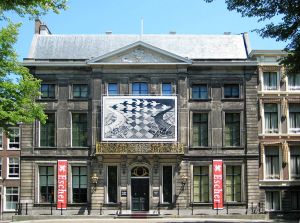While the Mauritshuis was closed for two years, a hundred pictures went up the road to The Hague’s remarkable Gemeentemuseum Den Haag. There, a significant last-minute decision in the Mauritshuis renovation programme took place. While hanging the paintings on the stark white walls, Mauritshuis chief curator Quentin Buvelot and his colleagues began to play with colours for their own galleries. ‘We experimented and saw how blue was very good for the Rubens portraits; it enhances what you see, shows the pictures to advantage.’ They applied their findings.
The pictures, meanwhile, slipped into the Gemeentemuseum collection happily. The building may be a handsome and pristine Art Deco work of 1931–35 by the Dutch architect H P Berlage, and its collection may be known more for Mondrian than its historic objects; but the 17th-century pictures sat well in the domestic sized rooms near galleries of extravagant silver, colonial carved wood, shelves of blue-and-white Delftware, and its period rooms reflecting Holland’s wealthy trading heyday.
The period rooms were part of Berlage’s original design and are the only ones of their kind in the Netherlands. Yet the museum’s strength is indeed modern and contemporary, ranging through Art Nouveau furniture, Expressionist painting and the Hague School of artists to a notable fashion department and a renowned Mondrian and De Stijl collection. Some 300 Mondrian pieces include his Victory Boogie Woogie of 1942–44, while the spare, functional De Stijl designs are by Mondrian and his companions such as Theo van Doesburg, Vilmost Huszár, Gerrit Rietveld.
The Gemeentemuseum has a splendid annexe, the city-centre Het Paleis on Lange Voorhout boulevard, a moment’s walk from the Mauritshuis. This served as the Queen Mother Emma of the Netherlands’ winter palace 1901–34, and was then used by Queen Mothers Wilhelmina, Juliana and Beatrix until 1984. Since 2002, its elegant rooms exhibit the museum’s collection of Dutch graphic artist M C Escher (1898–1972). Prints, some surprisingly big, include the well-known Italian and Greek landscapes, Air and Water, and a light blue version of Day and Night made for his eldest brother. Focusing on these closely, it is easy to miss the 1991–2 Donald Judd floors and Hans van Bentem’s 15 glass chandeliers.
More from The Hague
The Hague’s Hidden Treasures: Prince William V’s Picture Gallery
The Hague’s Hidden Treasures: Museum Bredius
Reopening the jewel box: the Mauritshuis opens its doors
Unlimited access from just $16 every 3 months
Subscribe to get unlimited and exclusive access to the top art stories, interviews and exhibition reviews.















![Masterpiece [Re]discovery 2022. Photo: Ben Fisher Photography, courtesy of Masterpiece London](http://www.apollo-magazine.com/wp-content/uploads/2022/07/MPL2022_4263.jpg)
It’s time for the government of London to return to its rightful home